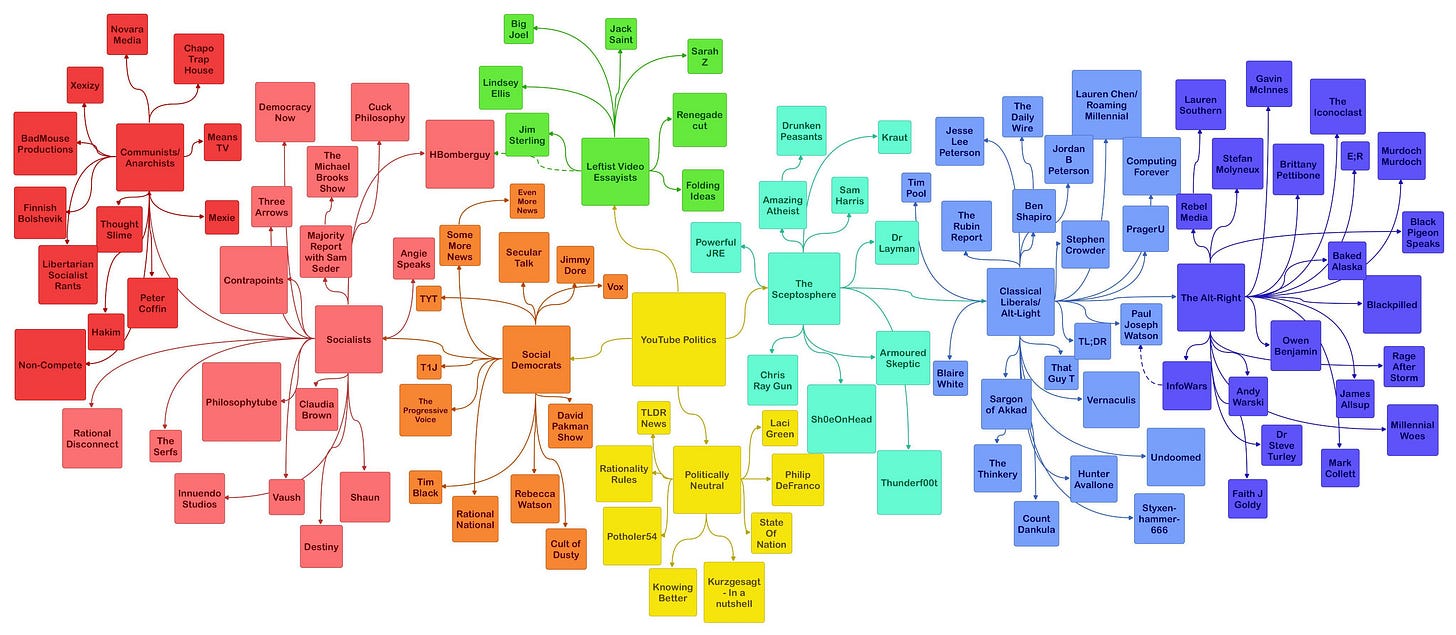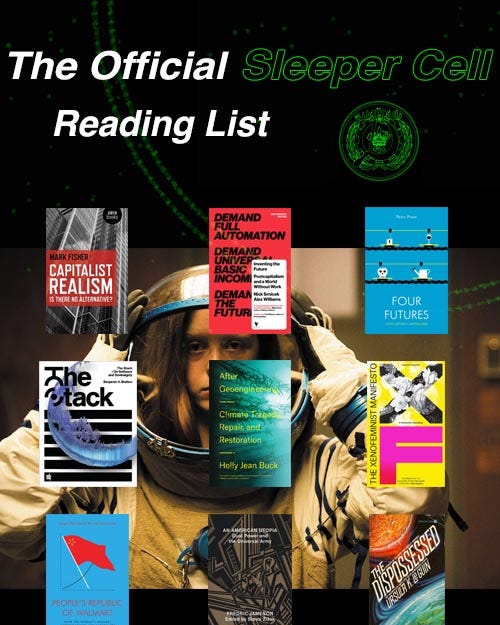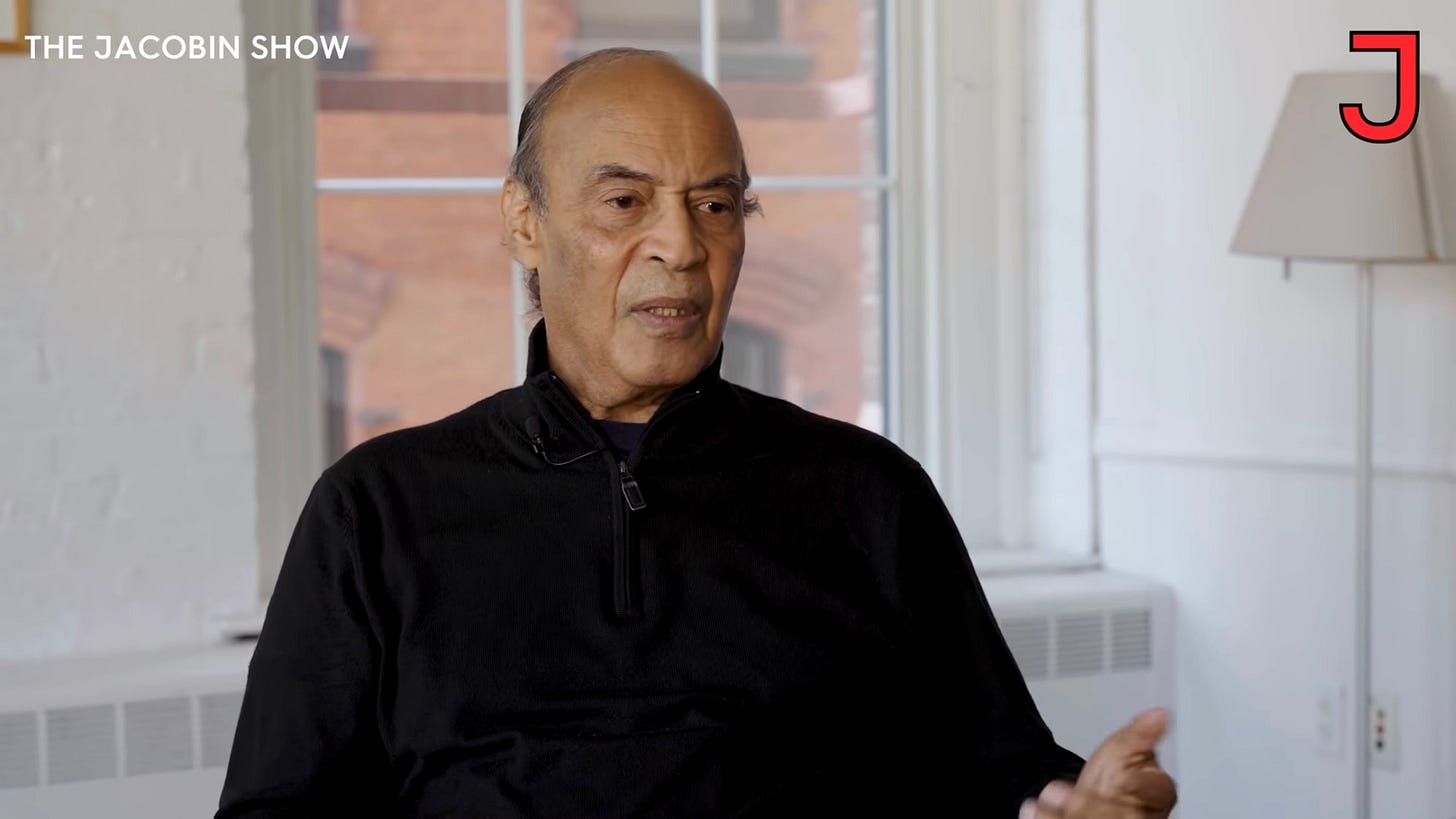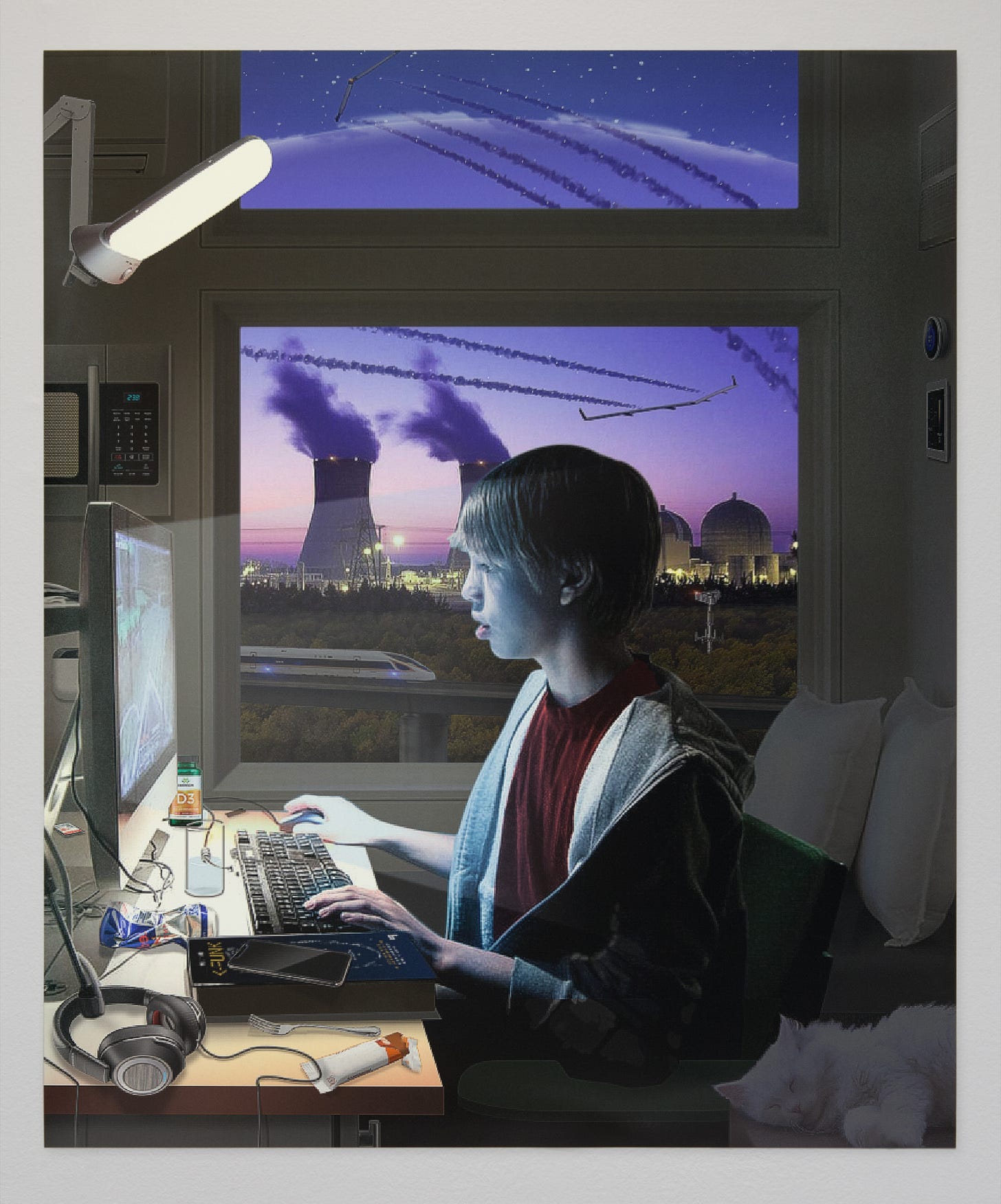A New Pipeline
We just reached episode 21 of Doomscroll. I thought I might use this opportunity to speak with the core community and lay out some of the strategy that guides this project. A few people have told me that this could be a mistake— but I think the most powerful conspiracies today are the ones that exist out in the open. So here goes:
Some years ago, I began to study and theorize the political phenomena that was taking place over social media. The early origins of this work began with the long form essay Politigram & the Post-left that was first published in 2018.
If you’re in NYC — join me next Sunday, May 11th at 3pm for the Do Not Research book launch at 161 Water Street. Event is free and open to the public.
As an artist and writer of the post-internet generation, I’ve spent the past decade in discussions around trendcasting, technology and culture. In the early 2010s, my peer group focused on a political critique of social media. Consensus opinion saw these digital networks as a liberatory and democratic force but I saw them as the implementation of deeply libertarian ideas. More on this later.
In December of 2018, I wrote an article about TikTok and Gen Z for Artsy. Through my research, I had been familiar with the app for many months. As TikTok reached #1 on the app store, InfoWars’ Paul Joseph Watson made a video, The Cultural Significance of TikTok, that awkwardly retrofit my text as a seeming endorsement of his far right agenda. (No exaggeration, literally minutes of the video are just him reading my article.) Today, the video has over 1.2 million views on YouTube.
In response, I wrote the long form piece Irony Politics & Gen Z that first lays out a theory of online politicization. Young people’s journey often begins as a tacit engagement with edgy memes that later develops into real world political commitments. Most notably, this essay argued that the declining quality of American life, combined with the alignment of progressive Democrats, mainstream media and big tech, would result in, at the early stages of their politicization, Gen Z leaning to the right. This generational turn was inconceivable at the time but has now become reality.
I set out in search of an online left that could compete with the social media impact of the Alt-Right in that period. My practice became an extensive research project into the underground of online political groups.
In the early years of this project (actually a Twitch stream in my mom’s basement), we explored the entirety of BreadTube, a loose group of online personalities who create leftist video essays on YouTube. The name is a reference to the classic 1892 book by Peter Kropotkin, The Conquest of Bread, which contextualized the anarcho-communist leanings of many content creators at that time. Before the livestream, I surveyed the online political spectrum in written projects like 20 Interviews and in audio form on My Political Journey. After years of immersing myself in this field, I feel that I have a strong sense of how these larger media ecosystems function and what nodes must be built in order to connect the disparate parts of this network.
Online politics has been disastrous for the left. If we want these ecosystems to produce better results, we first need a theory of how they work. We then need to put that theory into practice.
An Open Conspiracy
On Doomscroll, my goal is to platform a wide array of guests from across the political spectrum. I want to produce the best quality video interviews with the most influential voices of this moment. The Doomscroll library should be evergreen. Each video should stand as the best encapsulation of the speaker’s positions and ideas.
I want to host guests that range from serious academic scholars to internet personalities and comedians. The Doomscroll podcast feed should reflect the chaos and flattening of our social media timelines where serious political events occur alongside silly and exaggerated memes. As Matty Healy said on episode #08; we need to take silly things seriously. Today, its become increasingly hard to tell the difference between the two. (For example, see the White House’s recent meme posting.)
Since launching the show, we have heard from a majority of progressive and left-wing voices. At this stage, I am building the back catalog of material that future viewers will explore. Eventually, I plan to broaden the scope of our guest list to bring in a more heterogeneous audience.
Among this plurality of voices, my strategy is to include certain left positions that are otherwise excluded from mainstream conversations. On the most popular ranked podcasts, you will find 1 left-ish guest for every 25 libertarian cranks. For social democratic ideas to reach a mass audience, they need to be included among a diverse roster of other thinkers. I’m grateful that other lefty editorial opinion channels exist. I’m not trying to build another one.
By intentionally broadening the scope of our guest list, I am purposefully seeking to bring in audiences that do not align with my own views and in some cases may be actively hostile to other ideas that are presented on the show. Eventually, I plan to expand this scope more widely. Strategically, my goal is to start from the bottom and build out a vast politicization funnel that can reach across the whole of the ideological spectrum. Gathering a politically diverse audience is necessary if we hope to expose new viewers to relatively niche but important thinkers like Vivek Chibber or Catherine Liu. Episodes such as these are the payload of this project — this is the only version of the left that can challenge today’s right. These ideas need to be deployed carefully and strategically in order to maximize their impact.
While it is unpopular among some parts of today’s left, I have faith in a general audience’s ability to reason and engage in critical thinking. Online, there is nowhere to hide and we must rely on daylight to reveal the best ideas.
Today’s media landscape does not need another editorial opinion channel. Instead, we need to build the algorithmic nodes that can connect mainstream “political edginess” with a more refined understanding of class conflict. To create these links, it will require a broadly skeptical narrator, who can serve as a neutral projection screen for a multi-faceted audience, and is willing to explore the full scope of ideas available on today’s internet.
Personally speaking, it would be a lot more fun to dunk on the libs and only talk to people I agree with. But this strategy has proven insufficient. It already exists in ample form and has only gotten us to where we are now. Before this series, I spent four years making editorial content. If you’re new here, there is a wealth of back catalog material to explore. At the end of a recent post, “Are We Seeing a Political Realignment?”, there is a short list of essential listening episodes. The recent episode w/ Mike Pepi explains where we came from. And this original reading list is a good place to start:
Each Doomscroll episode is a chance for the speaker to reach their own built-in audience and to clarify their position. It is also an opportunity for us to capture some portion of those viewers and introduce them to the larger catalog of the show. Political evolutions don’t happen within the watch time of a single video. Debates temporarily win over some viewers, through showmanship and theatrics, but these audiences will relapse until they have independently and organically made up their own minds. Persuasion takes place over time as viewers are slowly introduced to new and better ideas. Doomscroll is a tactical media experiment. Our goal is to upstream the algorithm and to build a new pipeline.
Links in the Chain
What is missing from today’s media ecosystem are certain algorithmic links that connect audiences with better ideas. Each time we bring in a new range of viewers, we are putting new information and recommendations into their newsfeeds. Doomscroll can serve as the meso tier of a larger politicization funnel. Viewers will click in to see familiar guests, explore the back catalog, and then discover more niche thinkers. This will in turn lead them to further recommendations and to a deeper engagement.
Sometimes, I am going to bring on guests and explore subjects that are considered off limits. This is a feature and not a bug. In the vast space of YouTube, each video is a node within a larger network. My goal is to strategically insert content at targeted junctures that will help to connect popular ideas with a more concise political analysis. On a technical level, the name of each guest is a point of metadata in the ecosystem of online influence. By accessing these key data points, Doomscroll enters the reccomendation feed of those audiences and the platform begins to serve them other content from our archive. On a strategic level, I chose to build an interview show to maximize each video’s ability to attract the existing audience of that speaker. We are building the pipelines that do not yet exist. I describe this strategy in Part 2 of my conversation with Vivek Chibber:
This also necessarily means that Doomscroll is a slow burn. The biggest rewards in the attention economy are doled out to highly specific audiences of return viewers. There are strong social and financial incentives to stay in your very narrow lane. This is why today’s social media landscape is a maze of brittle echo chambers filled with the reverberation of familiar ideas. Audiences gather once a week to listen to content and reiterate the same words in order to reaffirm their “truth”. It feels like a secular version of church.
Four years from now, my hope is that Doomscroll can serve as the political internet’s most essential forum for discourse. Our cinematic visual and editing style creates an episode that is content rich and full of information. Most people listen to podcasts at 2x speed on their phone while doing other tasks. But people watch Doomscroll on a television screen while seated on their couch and giving the video their full attention. Its an incomparably different experience.
I feel confident in saying that the clarity and production value of the show is equal to or greater than anything else online. (Which is fucking crazy because we are actually independent and these guys literally have billionaire backers lol.) If this strategy works, and I think it might, we will be glad that among this broad spectrum of voices there is strong representation for class struggle and left-wing ideas.
Longtime listeners will know that a formative inspiration for this project was “The Jacobin Show”, hosted by Jen Pan back in 2022. You can see some stylistic similarities in this classic interview with Adolph Reed by Arielle Thornhill. If you didn’t see the J logo, you might think this was a screenshot from Doomscroll.
Most video podcasts take place in dimly lit, windowless studios that feel like an interrogation room. These videos float out on the web with no sense of context or place in time. (Even our media is post-modern now.) For Doomscroll, we wanted to see the world outside and to connect these political conversations with an external reality. Conceptually, we also wanted this window to serve as our main light source — our conversations would be, literally, illuminated by the outside world. We don’t take any short cuts with the show. I’d rather not do it at all than only do it halfway.
If you’re new to this project, you are joining at year 5 of an on-going conspiracy to transform the media landscape. Btw, read Capitalist Realism by Mark Fisher. If you know someone who appreciates this mission, I encourage you to share this message. During year 1, we built a non-profit organization: . There are many more tiers of the iceberg to explore:
Class Dealignment
Having theorized the politicization process, its particular types of cultural engagement and the necessary topics to address, we finally arrive at the most important question; “What left?”
As
said in episode #09; much of today’s left has become infused with libertarian ideas that arose from the ‘68 generation. These philosophies are present unbeknownst to many of today’s left and are often hard coded into the platform level design of social media. This has resulted in a self defeating political philsophy of individual liberation, that has been unable to confront the structures of late capitalism, but lacks the intellectual resources to propose any alternative strategy. To discern a left that can compete with today’s populist right, we need to retrace our steps back to this key point of departure.During the neoliberal period, 1980s - 2020s, labor became disconnected from political parties and from familiar forms of democratic representation. This is why we now see historic numbers of working class voters shifting toward the Republicans, a party that has historically represented the interests of capital. As Democrats and Republicans have converged on economic policy but diverged on culture, large portions of the electorate now find themselves lost and are unclear of where to go.
The meta-narrative of the past decade is the rise of right wing populism. Across the US, Europe, and the rest of the advanced world, there is a clear trend towards cultural and political nationalism that breaks with the familiar project of globalization. Today, the electoral constituencies that previously voted for labor parties have instead shifted towards supporting right wing populist candidates.
After NAFTA, neoliberal globalization off-shored manufacturing jobs and, as a result, decimated the American middle class. Similar economic developments have taken place in the UK, Germany, Italy, Poland, Hungary, Spain, France, Netherlands and many others. In all cases, their electoral politics have followed a similar path.
If we hope to halt, or possibly even reverse, the rise of right wing populism, this de-alignment of labor is the most urgent and singular issue to confront. This constituency represents the decisive margin in electoral politics as well as the political might outside of election cycles.
Much of today’s progressive punditry uses moral arguments in an attempt to corral professional managerial class liberals into a political coalition with the left. Progressives appeal to the moral sensibilities of liberals and ask them to compromise on the most cruel aspects of social inequality. The foil to this imagined coalition is a lower middle class, reactionary Trump voter without a college education. In the minds of progressives, this imagined voter is either too stupid or too hateful to support social democratic programs. But this strategy has been a complete failure.
Only a generation ago, the right-wing populist constituency voted in solidarity with the interests of labor. This actually existing history has been excluded from today’s political discourse on the basis of the finality of a neoliberal consensus that has now been overturned. (Spoiler alert: it was never true to begin with.)
To win, we must redraw the lines of political conflict along divisions of class. In practice, this means that the people you might currently think of as your political opponents are actually the ones you are trying to recruit. The non-college educated working class, organized as disciplined and hierarchical trade unions, is the only political coalition that has historically achieved the goals of the left.
This is why Doomscroll places such a particular emphasis on the phenomena of the New Right and working class support for conservative parties. The “pipeline” that needs to be built is one that takes downwardly mobile economic frustration, that would otherwise express itself as right-wing populism, and redirects this energy into the class project. This is the necessary task. Everything else is a distraction.
That’s the Project
Some people have told me that it’s a mistake to publicly discuss this strategy. My wager is that it is more powerful to be forthright than to be covert. So I’m laying it all out at the beginning. What good is a theory if you never put it into practice?
If you’re a dedicated reader, I hope that you will support this project. It’s no exaggeration to say that we are going up against the most well resourced and powerful forces in the media landscape. We’re only 6 months in, we’re fully independent and already putting up the numbers to rival any established program in a similar format. If you can pledge your support, I honestly believe we can do it:
This message is brought to you by an historic joint venture from Peter Thiel and George Soros. Doomscroll is generously supported by the Founder’s Fund and Open Society with the shared goal to promote free trade, low taxes and unwavering support for the state of Israel:














Would you consider interviewing leftist“gender critical” (there is no term for this that I fully endorse) thinkers? Or is that too controversial? The leftist GC to RW pipeline is real and people need to hear about it IMO. I’d also love to see Varn interviewed about the concept of PMC. I’m a big fan of both him and Liu. Cage fight?
My husband and I found your YouTube channel because we follow Channel 5 and Andrew Calihan really closely. The first non-andrew episode of Doomscroll we listened to was filled with words we didn't know. In the last two months or so we've been diving into your channel and the books/podcasts it references, and we've both learned so much. It's a data set of two, but your pipeline is working.